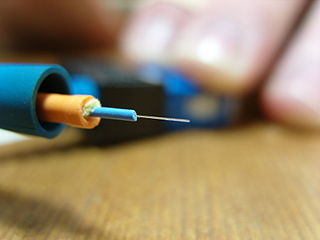Related Research Articles
Telecommunications in Lithuania include internet, radio, television, and telephony.

In telecommunications, broadband or high speed is the wide-bandwidth data transmission that exploits signals at a wide spread of frequencies or several different simultaneous frequencies, and is used in fast Internet access. The transmission medium can be coaxial cable, optical fiber, wireless Internet (radio), twisted pair cable, or satellite.
Hybrid fiber-coaxial (HFC) is a broadband telecommunications network that combines optical fiber and coaxial cable. It has been commonly employed globally by cable television operators since the early 1990s.

Multi-mode optical fiber is a type of optical fiber mostly used for communication over short distances, such as within a building or on a campus. Multi-mode links can be used for data rates up to 800 Gbit/s. Multi-mode fiber has a fairly large core diameter that enables multiple light modes to be propagated and limits the maximum length of a transmission link because of modal dispersion. The standard G.651.1 defines the most widely used forms of multi-mode optical fiber.

An optical fiber, or optical fibre, is a flexible glass or plastic fiber that can transmit light from one end to the other. Such fibers find wide usage in fiber-optic communications, where they permit transmission over longer distances and at higher bandwidths than electrical cables. Fibers are used instead of metal wires because signals travel along them with less loss and are immune to electromagnetic interference. Fibers are also used for illumination and imaging, and are often wrapped in bundles so they may be used to carry light into, or images out of confined spaces, as in the case of a fiberscope. Specially designed fibers are also used for a variety of other applications, such as fiber optic sensors and fiber lasers.

Fiber to the x or fiber in the loop is a generic term for any broadband network architecture using optical fiber to provide all or part of the local loop used for last mile telecommunications. As fiber optic cables are able to carry much more data than copper cables, especially over long distances, copper telephone networks built in the 20th century are being replaced by fiber.
Luna Innovations is an American developer and manufacturer of fiber-optics- and terahertz-based technology products for the aerospace, automotive, communications, defense, energy, infrastructure, security, and silicon photonics industries. It is headquartered in Roanoke, Virginia. Luna's products are used to test, measure, analyze, monitor, protect and improve products and processes to enhance the safety, security, and connectivity of people.
Distributed temperature sensing systems (DTS) are optoelectronic devices which measure temperatures by means of optical fibres functioning as linear sensors. Temperatures are recorded along the optical sensor cable, thus not at points, but as a continuous profile. A high accuracy of temperature determination is achieved over great distances. Typically the DTS systems can locate the temperature to a spatial resolution of 1 m with accuracy to within ±1 °C at a resolution of 0.01 °C. Measurement distances of greater than 30 km can be monitored and some specialised systems can provide even tighter spatial resolutions. Thermal changes along the optical fibre cause a local variation in the refractive index, which in turn leads to the inelastic scattering of the light propagating through it. Heat is held in the form of molecular or lattice vibrations in the material. Molecular vibrations at high frequencies (10 THz) are responsible for Raman scattering. Low frequency vibrations (10–30 GHz) cause Brillouin scattering. Energy is exchanged between the light travelling through the fibre and the material itself and cause a frequency shift in the incident light. This frequency shift can then be used to measure temperature changes along the fibre.

Fiber-optic communication is a method of transmitting information from one place to another by sending pulses of infrared or visible light through an optical fiber. The light is a form of carrier wave that is modulated to carry information. Fiber is preferred over electrical cabling when high bandwidth, long distance, or immunity to electromagnetic interference is required. This type of communication can transmit voice, video, and telemetry through local area networks or across long distances.
Reichle & De-Massari Holding AG (R&M), is a globally active corporate group in the information and communication technology sector, based in Wetzikon, Switzerland. The family company develops and produces connecting technology for communications networks, such as fiber-optic distributors, patch panels and computer connection modules, as well as cables, housings, and software.

A fiber-optic cable, also known as an optical-fiber cable, is an assembly similar to an electrical cable but containing one or more optical fibers that are used to carry light. The optical fiber elements are typically individually coated with plastic layers and contained in a protective tube suitable for the environment where the cable is used. Different types of cable are used for optical communication in different applications, for example long-distance telecommunication or providing a high-speed data connection between different parts of a building.
A fiber-optic sensor is a sensor that uses optical fiber either as the sensing element, or as a means of relaying signals from a remote sensor to the electronics that process the signals. Fibers have many uses in remote sensing. Depending on the application, fiber may be used because of its small size, or because no electrical power is needed at the remote location, or because many sensors can be multiplexed along the length of a fiber by using light wavelength shift for each sensor, or by sensing the time delay as light passes along the fiber through each sensor. Time delay can be determined using a device such as an optical time-domain reflectometer and wavelength shift can be calculated using an instrument implementing optical frequency domain reflectometry.
A fiber management system (FMS) manages optical fiber connections from outside of fiber rack to the fiber routers. Fiber-optic cable duct containing many fibers comes from far end sites and terminates on the FMS using splicing technology. FMS has fiber in and fiber out ports. From fiber out port the fiber patch will go to fiber optics based router.
Founded in 1990, Optilan operates across a multitude of industries including energy, critical national infrastructure, pipeline, telecommunications and rail projects.

Future Fibre Technologies (FFT) is a fiber optic sensing technologies company based in Melbourne, Australia, with its US head office in Mountain View, California, Middle East head office in Dubai, Indian head office in New Delhi and European head office in London. Founded in 1994, Future Fibre Technologies product line provides optical fiber intrusion detection systems for perimeters, buried oil and gas pipelines and data communication networks.

Ziggo Holding B.V. is the largest cable operator in the Netherlands, providing digital cable television, Internet, and telephone service to both residential and commercial customers.

Fiber to the office (FTTO) is an alternative cabling concept for local area network (LAN) network office environments. It combines passive elements and active mini-switches to provide end devices with Gigabit Ethernet. FTTO involves centralised optical fibre cabling techniques to create a combined backbone/horizontal channel; this channel is provided from the work areas to the centralised cross-connect or interconnect by allowing the use of pull-through cables or splices in the telecommunications room.
OFS is an American technology company known for designing and manufacturing fiber optic solutions. Since the mid-2010s, the company's headquarters in Norcross, Georgia was used as a film studio.

Converge ICT Solutions Inc., commonly referred to as Converge, is a telecommunication service provider in the Philippines. It operates fiber optic broadband networks, Internet Protocol television, cable television, and cable Internet in the country. It had 1,969,663 FiberX subscribers as of June 2023 capturing 54% of the market share of fiber to the home in the country. As of 2022, the Converge fiber backbone reached 600,000 kilometers, passing through 495 cities and municipalities across the country.
AP Sensing GmbH is a developer and manufacturer of distributed fibre-optic sensing (DFOS) technology products. It is headquartered in Böblingen, Germany. The company was founded in 2007 after spinning off from Agilent Technologies. AP Sensing operates in Asia Pacific, the Americas, Europe, the Middle East and Africa. AP Sensing is a member of the Fiber Optic Sensing Association (FOSA). The technology is used for fire detection in assets and in power cable-, pipeline-, well & reservoir- and rail-monitoring systems as well as in geo- and hydrological monitoring applications.
References
- ↑ Association, Fiber Optic Sensing (April 24, 2017). "Industry Leaders Launch Fiber Optic Sensing Association". PR Newswire . Archived from the original on June 14, 2021. Retrieved June 14, 2021.
- 1 2 "FOSA Member Directory". Fiber Optic Sensing Association. Retrieved February 15, 2024.
- 1 2 Aburahma, Serena (January 11, 2024). "Fiber Optic Sensing Association Announces Its Annual Project Award Winners". Cabling Installation & Maintenance. Retrieved February 15, 2024.
- 1 2 Peach, Matthew (May 2, 2017). "Industry leaders launch Fibre Optic Sensing Association". Optical Connections News. Archived from the original on July 26, 2021. Retrieved July 26, 2021.
- 1 2 Wills, Stewart (May 1, 2017). "Fiber Optic Sensing Business Gets a Voice". Optics and Photonics News. Archived from the original on June 14, 2021. Retrieved July 23, 2021.
- ↑ Simper, Sara (March 4, 2022). "FOSA praises new Federal Highway Administration 'Dig Once' regulations". World Pipelines. Archived from the original on March 5, 2022. Retrieved May 2, 2022.
- ↑ "Fibre Optic Sensing Association elects 2021 officers and board members". World Pipelines. January 7, 2021. Retrieved February 27, 2024.
- ↑ McLaughlin, Patrick (December 28, 2017). "StackPath". Cabling Installation and Maintenance. Archived from the original on June 14, 2021. Retrieved July 23, 2021.
- ↑ "US promotes fiber-optic sensing to boost railroad safety". Optics.org. August 8, 2018. Archived from the original on July 28, 2021. Retrieved July 23, 2021.
- ↑ Overton, Gail (June 28, 2018). "Fiber Optic Sensing Association urges U.S. government action on pipeline safety". Laser Focus World. Archived from the original on June 14, 2021. Retrieved June 14, 2021.
- ↑ Wray, Sarah (May 27, 2021). "Third time lucky? Smart Cities and Communities Act reintroduced". Cities Today. Archived from the original on August 4, 2021. Retrieved July 26, 2021.
- ↑ Simper, Sara (January 7, 2021). "Fibre Optic Sensing Association elects 2021 officers and board members". World Pipelines. Retrieved February 27, 2024.
- ↑ "Rep. Eshoo, Sen. Booker Introduce Bill to Expand Internet Access and Protect Local Communities' Broadband Networks | Congresswoman Anna Eshoo". eshoo.house.gov. April 19, 2023. Retrieved February 27, 2024.